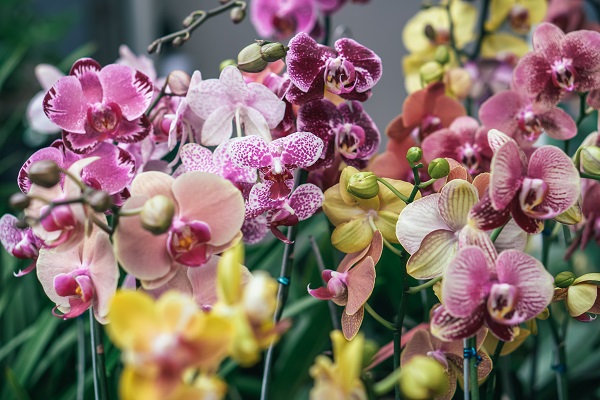
Don’t stop reading…. it’s not what you think!
Once the growing environment is up and running and your plants are growing, thriving, and blooming, it’s time to get to know them up front and personal.
Let’s start with the plant itself. Orchids are classified into to groups; Sympodial and Monopodial. Knowing the plants growth habit will help determine how to pot them and what potting media to use.
Sympodial Orchids
These are Orchids, such as the Cattleya and its family. They grow from several growing points along a rhizome, growing vertically, which will eventually produce the pseudobulb, a swollen bulb at the base of the leaf used for water storage, the leaf, which provides photosynthesis and eventually the flower, which will allow the plant to reproduce in its natural conditions. Plants should be potted into a suitable container, in a porous, freely flowing potting mixture, specifically formulated for Orchids. Typically, a redwood fir bark mixture, although there are many, many excellent alternatives available in today’s market. These plants may also be attached to any number of growing surfaces or “mounted”. Once the plant is un-potted and cleaned (always use sterile cutting tools) select a suitable mount, which can be any hardwood (do not use wood from any fruit or nut tree as it produces an acid that will kill the plant) tree fern or cork slab. Place a small amount of sphagnum moss between the plant and its mount, then secured it with clear filament fishing line. This will allow its roots to grow into the moss and eventually onto the surface. The bottom line is, use what works best for you!
Monopodial Orchids
Examples are Phalaenopsis and Vanda, and they grow from a central main stem and typically grow vertically. These plants do not have the water storing ability that Cattleya’s do and therefore lack the ability to store water, requiring more frequent watering. Although some can be mounted as noted above very successfully, most do best when potted using any number of potting media available today.
As mentioned previously, Orchid Flowers can range from ultra tiny to relatively large, but in any case, share the same basic characteristics:
Two petals
Three sepals
The Lip (or Labellum)
And the Column (which consists of the anther cap and pollen)
There are exceptions to this rule, as some plants are considered “Peloric”, in other words they can actually produce, for example, 3 lips! A typical centered lip and 2 more replacing both petals! These type plants can sometimes demand very high prices.
Unless pollination is done by hand, most Orchids in nature have very specific pollinators. For example, Angraecum veitchii, with its beautiful waxy flower and long (sometimes up to 6 inch) “spur”, is extremely fragrant at night. This is an attempt to attract a very specific type of moth, with an equally long proboscis, to sip the nectar and in turn pollinate the flower.
Once an Orchid flower is pollinated, it can take up to a year for the seed capsule to mature, then once mature the tiny dust like seeds, must be sown in a sterile laboratory, in glass jars. Believe it or not it can take up to 7 years from sewing to blooming for an Orchid plant, which accounts for the relatively high cost of even a small seedling.
Tom Capranica has been a hobby collector and hybridizer of Orchids for over 20 years, and an active member of the American Orchid Society for about the same length of time. He grows his Orchids in a 450 sq. ft. climate-controlled greenhouse, containing over 300 plants of various genera, primarily Cattleya.
Related Articles & Free Email Newsletter Sign Up
4 Popular Orchid Propagation Methods
A Quick Tutorial in Orchid Nomenclature or “Know Who You Have!”
To Pot or Not to Pot an Orchid, That is the Question!




Comment here